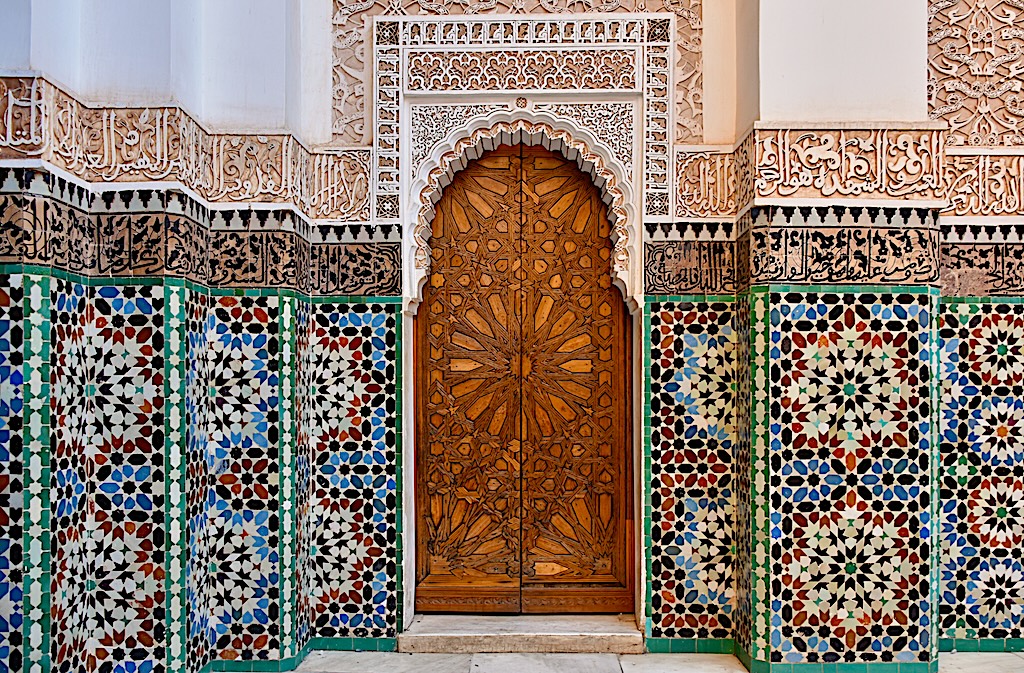Arabic architecture represents one of the finest arts that reflect the spirit of Islamic civilization and the history of the Arabs throughout the ages. It was not limited to mere stone structures but emerged as the result of the interaction of environmental, religious, and social factors, embodying a deep spirit of innovation and beauty.
Arabic architecture is distinguished by the diversity of its elements, such as arches, domes, and minarets, along with geometric and floral decorations that appear in the details of buildings, and Arabic calligraphy, which became a fundamental decorative element on walls. The use of these elements is a profound expression of aesthetic and artistic depth, clearly visible in unique architectural sites such as the Makki Mosque in Mecca, the Prophet’s Mosque in Medina, the Great Mosque of Córdoba in Andalusia, and the Blue Mosque in Istanbul. These landmarks represent living examples of the harmony between function and beauty in Islamic architecture.
Arab buildings were not merely places to live but were designed to express religious and social values. Mosques were dedicated to worship and learning, while markets were created to organize daily life and enhance commercial and social interaction. Despite the passage of time, the influence of Arabic architecture remains evident, continuing to inspire architects and engineers worldwide with its originality and innovation.
العِمَارَةُ العَرَبِيَّةُ تُمَثِّلُ وَاحِدَةً مِنْ أَرْقَى الفُنُونِ الَّتِي تُجَسِّدُ رُوحَ الحَضَارَةِ الإِسْلَامِيَّةِ وَتَارِيخَ العَرَبِ عَلَى مَرِّ العُصُورِ. لَمْ تَقْتَصِرْ عَلَى مُجَرَّدِ الهَيَاكِلِ الحَجَرِيَّةِ، بَلْ جَاءَتْ نَتِيجَةَ تَدَاخُلِ عَوَامِلَ بِيئِيَّةٍ وَدِينِيَّةٍ وَاجْتِمَاعِيَّةٍ، فَتَعَمَّقَتْ فِيهَا رُوحُ الاِبْتِكَارِ وَالجَمَالِ.
تَمَيَّزَتِ العِمَارَةُ العَرَبِيَّةُ بِتَنَوُّعِ عَنَاصِرِهَا، مِثْلَ الأَقْوَاسِ وَالقِبَابِ وَالمَآذِنِ، إِلَى جَانِبِ الزَّخَارِفِ الهَنْدَسِيَّةِ وَالنَّبَاتِيَّةِ الَّتِي تَظْهَرُ فِي تَفَاصِيلِ المَبَانِي، وَالخَطِّ العَرَبِيِّ الَّذِي تَحَوَّلَ إِلَى عُنْصُرٍ زَخْرَفِيٍّ أَسَاسِيٍّ فِي الجُدْرَانِ. يُعَدُّ تَوْظِيفُ هَذِهِ العَنَاصِرِ تَعْبِيرًا عَمِيقًا عَنِ البُعْدِ الجَمَالِيِّ وَالفَنِّيِّ، كَمَا يُمْكِنُ مُلَاحَظَةُ ذَلِكَ بِوُضُوحٍ فِي مَوَاقِعَ مِعْمَارِيَّةٍ فَرِيدَةٍ مِثْلَ المَسجِد المَكِّي بِمَكَّةَ المُكَرَّمَةِ، وَالمَسْجِدِ النَّبَوِيِّ بِالمَدِينَةِ المُنَوَّرَةِ، وَمَسْجِدِ قُرْطُبَةَ فِي الأَنْدَلُسِ، وَمَسْجِدِ السُّلْطَانِ أَحْمَدَ فِي إِسْطَنْبُولَ. تُمَثِّلُ هَذِهِ المَعَالِمُ أَمْثِلَةً حَيَّةً عَلَى تَدَاخُلِ الجَانِبِ الوَظِيفِيِّ وَالجَمَالِيِّ فِي العِمَارَةِ الإِسْلَامِيَّةِ.
لَمْ تَكُنِ المَبَانِي العَرَبِيَّةُ مُجَرَّدَ أَمَاكِنَ لِلعَيْشِ فَقَطْ، بَلْ صُمِّمَتْ لِتُعَبِّرَ عَنِ القِيَمِ الدِّينِيَّةِ وَالاِجْتِمَاعِيَّةِ، حَيْثُ خُصِّصَتِ المَسَاجِدُ لِلعِبَادَةِ وَالعِلْمِ، وَجَاءَتِ الأَسْوَاقُ وَسِيلَةً لِتَنْظِيمِ الحَيَاةِ اليَوْمِيَّةِ وَتَعْزِيزِ التَّفَاعُلِ التِّجَارِيِّ وَالاِجْتِمَاعِيِّ. وَرَغْمَ مُرُورِ الزَّمَنِ، لا يَزَالُ تَأْثِيرُ العِمَارَةِ العَرَبِيَّةِ وَاضِحًا، إِذْ تَظَلُّ مَصْدَرَ إِلْهَامٍ لِلْمُعَمَّارِيِّينَ وَالمُهَنْدِسِينَ حَوْلَ العَالَمِ لِمَا تَحْمِلُهُ مِنْ أَصَالَةٍ وَابْتِكَارٍ..
https://forms.gle/kiEH4P3da4amxbMA9 اختبر نفسك
Test yourself https://forms.gle/rrZRqK7ekR8cJz9c9

